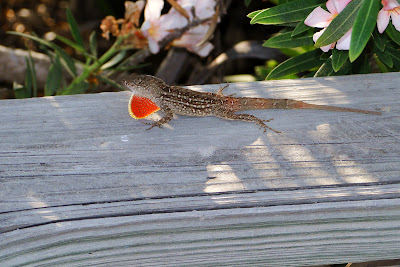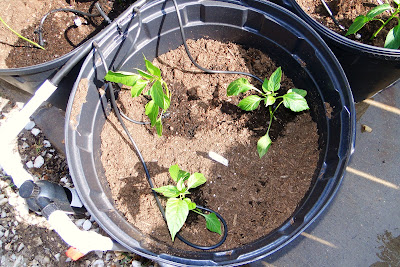Bugs have been enjoying the leaves on our pepper plants. As you can see the holes all over the leaves. After doing some research we tried spraying soap water on leaves and found some moderate possitive results. I have also heard from a neighbor that using small amount of garlic juice mixed with water and sprayed on leaves is a good deterant as well.
Saturday, June 30, 2012
Tuesday, June 12, 2012
Texas Brown Anole Lizard
One of the residents on our Alejandro Pepper farm is the Texas Brown Anole Lizard. These lizards are originally from Cuba and the Bahamas. On our farm he like to eat insects like spiders and cockroaches. This particular anole lost his tale at some point and grew back another one. Loosing their tales is a defensive move so they can get away from preditors like snakes and birds. Most likely our cat or dogs that enjoy chasing them around.
 |
| Male Brown Anole showing his bright orange frill. |
Saturday, June 9, 2012
First Pepper Blossoms for 2012
Our first pepper blossoms are coming out. Very exciting stuff as these pepper plants settle in their new home at Alejandro Pepper Farm. We gave them a shot of fertilizer and we can see a noticeable difference in their growth rate. Below is the first evidence of a blossom from the burpee sweet heat pepper plant.
Our irrigation system seems to be working out very well with a occasional blow-out on the tube connections. Hey, we've got 50 psi coming through these lines. Guess I'll have to get the zip ties out. Still watering 4 times a day with 2 minutes per cycle.
Friday, June 8, 2012
Paper Wasps vs Leafminer Flies
Our secret weapon against the leaf minors is the common paper wasp. They have built up a colony under the house easement above Alejandro Pepper Farm. These paper wasps are known to enjoy feeding on caterpillars, flies, and many other pesky insects that feed on our crops.
Though there sting can be strong, these wasps are basically social and only attack when defending themselves and their home. The nest pictured should be about as big as it gets since they're nest typically are up to about 30 wasps. I've destroyed these in the past but now I'm understanding the benefits they have for our garden. They pollinate and feed on nectar and eat flies to feed to their larva.
Though there sting can be strong, these wasps are basically social and only attack when defending themselves and their home. The nest pictured should be about as big as it gets since they're nest typically are up to about 30 wasps. I've destroyed these in the past but now I'm understanding the benefits they have for our garden. They pollinate and feed on nectar and eat flies to feed to their larva.
Thursday, June 7, 2012
Leafminer Flies on Pepper Plants
Do you have squiggly lines on your pepper leaves? We discovered several on our pepper plants and with a little research found out we had a leaf miner problem. You can see in the picture below what appears to be a squiggly trail created on the leaf. This is actually the larva from a leafminer fly. The larva are actually inside the leaf tunneling through and enjoying the needed nutrients to maturity.
Some websites recommend to cut the leaves off and place sticky traps around the plants to catch these flies. However, with more research there doesn't seem to be any remedy for this problem. The sticky traps may have some effect but certainly not a cure-all. We went ahead and placed several through-out our pepper plants and as been somewhat useful in capturing some of these pests. We did cut off some leaves but will do so sparingly in the future as to not hurt the plant.
We've also learned that I'll need to learn to co-exist with leafminers but attempt to keep them from getting out of hand. I've learned from other accounts that this doesn't effect your yield of peppers. Since this is our first year in growing peppers we are anxious to learn the outcome.
Some websites recommend to cut the leaves off and place sticky traps around the plants to catch these flies. However, with more research there doesn't seem to be any remedy for this problem. The sticky traps may have some effect but certainly not a cure-all. We went ahead and placed several through-out our pepper plants and as been somewhat useful in capturing some of these pests. We did cut off some leaves but will do so sparingly in the future as to not hurt the plant.
We've also learned that I'll need to learn to co-exist with leafminers but attempt to keep them from getting out of hand. I've learned from other accounts that this doesn't effect your yield of peppers. Since this is our first year in growing peppers we are anxious to learn the outcome.
Above are Serrano Pepper plants that seem to be thriving. In the back you can see a sticky trap that seem to be doing the job.
Tuesday, June 5, 2012
Pepper Leaves Turning White
After planting our peppers to there final location we started to see the leaves turning white. We discovered that this scalding was due to too much sun light. Our plants had started to go into a shock and we need to com up with some sort of a remedy.
We decided to act fast and we ran down to the local home improvement store (Lowes) to pick up some portable umbrellas to provide some shade while our peppers acclimate to their new environment.
Our peppers were grown in mostly shade from germination to juvenile. To move them to mostly sun was quite a shock and hopefully we caught it in time and not lose any plants.
We decided to act fast and we ran down to the local home improvement store (Lowes) to pick up some portable umbrellas to provide some shade while our peppers acclimate to their new environment.
Our peppers were grown in mostly shade from germination to juvenile. To move them to mostly sun was quite a shock and hopefully we caught it in time and not lose any plants.
Monday, June 4, 2012
Planting Alejandro Pepper Farm
Last Saturday we finally planted our peppers after nursing back the plants purchased from Burpee and our Serrano's we germinated from seeds. We lined the base of each 20 gallon pot with gravel and a secret ingredient you don't often find in this mixture. Look closely and you might see it...
Yep, those are sea shells my wife and I had gathered from several walks on the beach! After each walk we would place them around our mail box on top of the landscape rocks. Then recently we removed the rock and replaced it with hardwood mulch. So that's how we ended up with sea shells in our nursery pots. Who knows, it may be the reason we have a great pepper yield! Time will tell.
After planting all of our peppers we setup a drip system to automatically water each plant. Since we have very warm/hot weather we decide to start out watering 4 times per day for 2 minutes. We'll make adjustments as we go.
Our auto drip irrigation system allows us to make precision water at preferred times and not worry to much about it. Patti and I get a kick out of watching our peppers several times a day. ;o)
Yep, those are sea shells my wife and I had gathered from several walks on the beach! After each walk we would place them around our mail box on top of the landscape rocks. Then recently we removed the rock and replaced it with hardwood mulch. So that's how we ended up with sea shells in our nursery pots. Who knows, it may be the reason we have a great pepper yield! Time will tell.
We used Miracle-Gro potting soil and mixed with organic choice. Hopefully we'll have great results from the growth of our peppers over time with this soil/compost mix.
Our auto drip irrigation system allows us to make precision water at preferred times and not worry to much about it. Patti and I get a kick out of watching our peppers several times a day. ;o)
Subscribe to:
Posts (Atom)

















